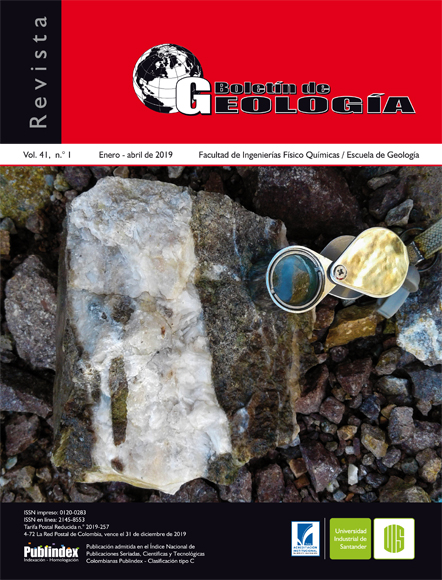Structural control of barite and copper mineralization at the district of Caracolí and Camperucho, Cesar, Colombia
Published 2019-01-08
Keywords
- Structural control,
- joints,
- fault,
- mineralization
How to Cite
Altmetrics
Abstract
Understanding structural controls is essential for understanding the sites of mineralized fluids, since geological structures develop a role as channels in the transport and precipitation of minerals. The study area comprises the rural area of the Caracolí district where outcrop mineralization of Barite and the rural area of the Camperucho where Copper mineralizations outcrops, both located to the south of the municipality of Valledupar, Cesar, Colombia. The analysis of the data collected on field showed a definite tectonic control of the mineralizations along a system of oriented faults NEE-SWW determined as N71E/81SE cutting volcanic and volcanosedimentary sequences associated with the Guatapurí formation, the Rhyodacite of the Tabanos and Espilitas Triassic units. These fractures allowed the rise of hydrothermal fluids enriched in barium (Caracolí) forming veins of barite, and the filtering of meteoric waters generating a secondary copper mineralization (Camperucho) represented on copper oxide and carbonate minerals. The structural control of the area is defined by inverse faults with sinistral movement product of simple shearing efforts with the following directions: σ1 and σ3, NNE and SEE respectively. The mineralizations of barite are emplaced
from compressive and shear efforts, measured on field generating inverse faults with sinistral movement allowing the siting of mineralizing fluids with "rosario" and "bolsons" shape, observed in the field along these areas of weakness. On the other hand, the copper oxide deposits are generated by secondary enrichment of volcanosedimentary litholigies with low grade of copper content throughout fault planes which allowed the filtration of meteorics water.
Downloads
References
Bayona, G., Lamus-Ochoa, F., Cardona, A., Jaramillo, C., Montes, C., y Tchegliakova, N. (2007). Procesos orogénicos del Paleoceno para la cuenca de Ranchería (Guajira, Colombia) y áreas adyacentes definidos por análisis de procedencia. Geología Colombiana, 32, 21-46.
Colmenares, F., Mesa, A., Roncancio, J., Arciniegas, E., Pedraza, P., Cardona, A., Romero, A., Silva, C., Alvarado, S., Romero, O., y Vargas, A. (2007).
Geología de las planchas 11, 12, 13, 14, 18, 19, 20, 21, 25, 26, 27, 33, 34 y 40. Proyecto: Evolución geohistórica de la Sierra Nevada de Santa Marta.
INGEOMINAS. Bogotá.
Corredor, F.H., y Mendoza, F.D. (2016). Caracterización mineralógica, geoquímica y génesis de las manifestaciones cupríferas de la zona Suroriental de la Sierra Nevada de Santa Marta, departamento del Cesar. Tesis, Universidad Industrial de Santander y Fundación Universitaria del Área Andina.
Etayo, F., Barrero, D., Lozano, H., Espinoza, A., González, H., Orrego, A., Ballesteros, I., Forero, H., Ramírez, C., Albers, J., Case, J., Singer, D., and Bowen, R. (1983). Mapa de Terrenos Geológicos de Colombia. Bogotá: Publicaciones Geológicas Especiales, INGEOMINAS, No 14.
IGAC. (2005a). Plano Topográfico 33-IV-A. Departamento del Cesar. Escala 1:25000. Instituto Geográfico Agustín Codazzi.
IGAC. (2005b). Plano Topográfico 33-IV-C. Departamento del Cesar. Escala 1:25000. Instituto Geográfico Agustín Codazzi.
Maestre, L., Toncel, H., y Rudas, A. (2014). Determinación de la calidad de los depósitos de Barita, en el corregimiento de Caracolí, municipio de Valledupar, Cesar. Revista Agunkuya, 14, 47-54.
Marrett, R.A., and Allmendinger, R.W. (1990). Kinematic analysis of fault-slip data. Journal of Structural Geology, 12(8), 973-986.
doi:10.1016/0191-8141(90)90093-E.
Montes, C., Guzman, G., Bayona, G., Cardona, A., Valencia, V., and Jaramillo, C. (2010). Clockwise rotation of the Santa Marta massif and simultaneous
Paleogene to Neogene deformation of the PlatoSan Jorge and Cesar-Ranchería basins. Journal of South American Earth Sciences, 29(4), 832-848.
doi: 10.1016/j.jsames.2009.07.010.
Ortega, C. (2011). Mineralización de Barita en volcánico mesozoicos en el municipio de Valledupar-Cesar, 6.2 Geología general.
Ortega, C., Rojas, E., y Manco, D. (2014). Mineralización de Cobre en el Sector de San Diego, Serranía del Perijá. Geología Colombiana, 37, 51-61.
Ortiz, H. (1991). Geología Minera del Oro de Veta. Texto Guía. COLCIENCIAS.
Reich, M., and Vasconcelos, P. (2015). Geological and economic significance of supergene metal deposits. Elements, 11(5), 305-310.
doi: 10.2113/gselements.11.5.305.
Tschanz, C., Jimeno, A., y Cruz, J. (1969). Mapa geológico de reconocimiento de la Sierra Nevada de Santa Marta y la Serranía del Perijá. INGEOMINAS.
Tschanz, C., Marvin R., Cruz J., Mehnert H., and Cebula, G. (1974). Geologic evolution of the Sierra Nevada de Santa Marta, Northeastern Colombia. GSA Bulletin, 85(2), 273-284. doi:10.1130/0016-7606(1974)85<273:GEOTSN>2.0.CO;2.

